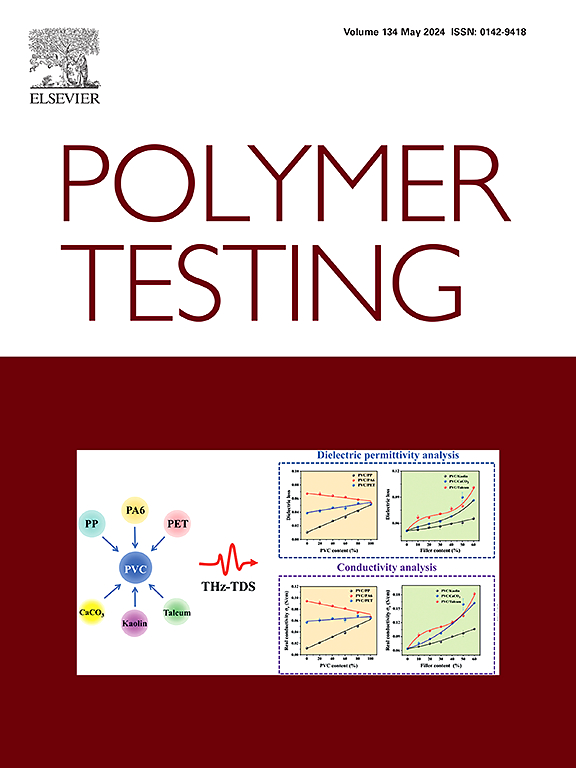Enhanced heat conductivity ingraphene/polyethylene nanocomposites through two-stage graphene dispersion using hyperbranched polyethylene
IF 6
2区 材料科学
Q1 MATERIALS SCIENCE, CHARACTERIZATION & TESTING
引用次数: 0
Abstract
Enhancing the thermal conductivity of polyethylene (PE) is critical for improving processing efficiency and reducing energy consumption. This study introduces a novel two-stage process to disperse graphene in PE using hyperbranched polyethylene (HBPE). A graphene-HBPE (G-HBPE) masterbatch was prepared via solution mixing and sonication of graphite in chloroform with HBPE, followed by solvent removal and melt mixing with low-density PE (LDPE). Incorporating less than 1 wt% graphene nanoplatelets (GNPs) increased thermal conductivity by 50 %, from 0.312 to 0.468 W/m·K, while preserving processability (melt flow index: 0.85 to 0.816 g/10 min) and modestly enhancing mechanical properties (modulus: 95.8–165.2 MPa). Field emission scanning electron microscopy revealed uniform graphene dispersion and strong interfacial bonding, attributed to HBPE's CH-π interactions and steric stabilization. This approach outperforms prior methods, offering a scalable strategy for PE-based thermal management materials in electronics and other applications.

利用超支化聚乙烯两阶段分散石墨烯,增强石墨烯/聚乙烯纳米复合材料的导热性
提高聚乙烯(PE)的导热性是提高加工效率和降低能耗的关键。本研究介绍了一种利用超支化聚乙烯(HBPE)在聚乙烯中分散石墨烯的新型两阶段工艺。将石墨与HBPE在氯仿中进行溶液混合和超声处理,然后与低密度PE (LDPE)进行溶剂去除和熔体混合,制备出石墨烯-HBPE (G-HBPE)母粒。加入不到1 wt%的石墨烯纳米片(GNPs)使导热系数提高了50%,从0.312到0.468 W/m·K,同时保持了可加工性(熔体流动指数:0.85到0.816 g/10 min),并适度提高了机械性能(模量:95.8-165.2 MPa)。场发射扫描电子显微镜显示,由于HBPE的CH-π相互作用和空间稳定,石墨烯分散均匀,界面键合强。该方法优于先前的方法,为电子和其他应用中的pe基热管理材料提供了可扩展的策略。
本文章由计算机程序翻译,如有差异,请以英文原文为准。
求助全文
约1分钟内获得全文
求助全文
来源期刊

Polymer Testing
工程技术-材料科学:表征与测试
CiteScore
10.70
自引率
5.90%
发文量
328
审稿时长
44 days
期刊介绍:
Polymer Testing focuses on the testing, analysis and characterization of polymer materials, including both synthetic and natural or biobased polymers. Novel testing methods and the testing of novel polymeric materials in bulk, solution and dispersion is covered. In addition, we welcome the submission of the testing of polymeric materials for a wide range of applications and industrial products as well as nanoscale characterization.
The scope includes but is not limited to the following main topics:
Novel testing methods and Chemical analysis
• mechanical, thermal, electrical, chemical, imaging, spectroscopy, scattering and rheology
Physical properties and behaviour of novel polymer systems
• nanoscale properties, morphology, transport properties
Degradation and recycling of polymeric materials when combined with novel testing or characterization methods
• degradation, biodegradation, ageing and fire retardancy
Modelling and Simulation work will be only considered when it is linked to new or previously published experimental results.
 求助内容:
求助内容: 应助结果提醒方式:
应助结果提醒方式:


